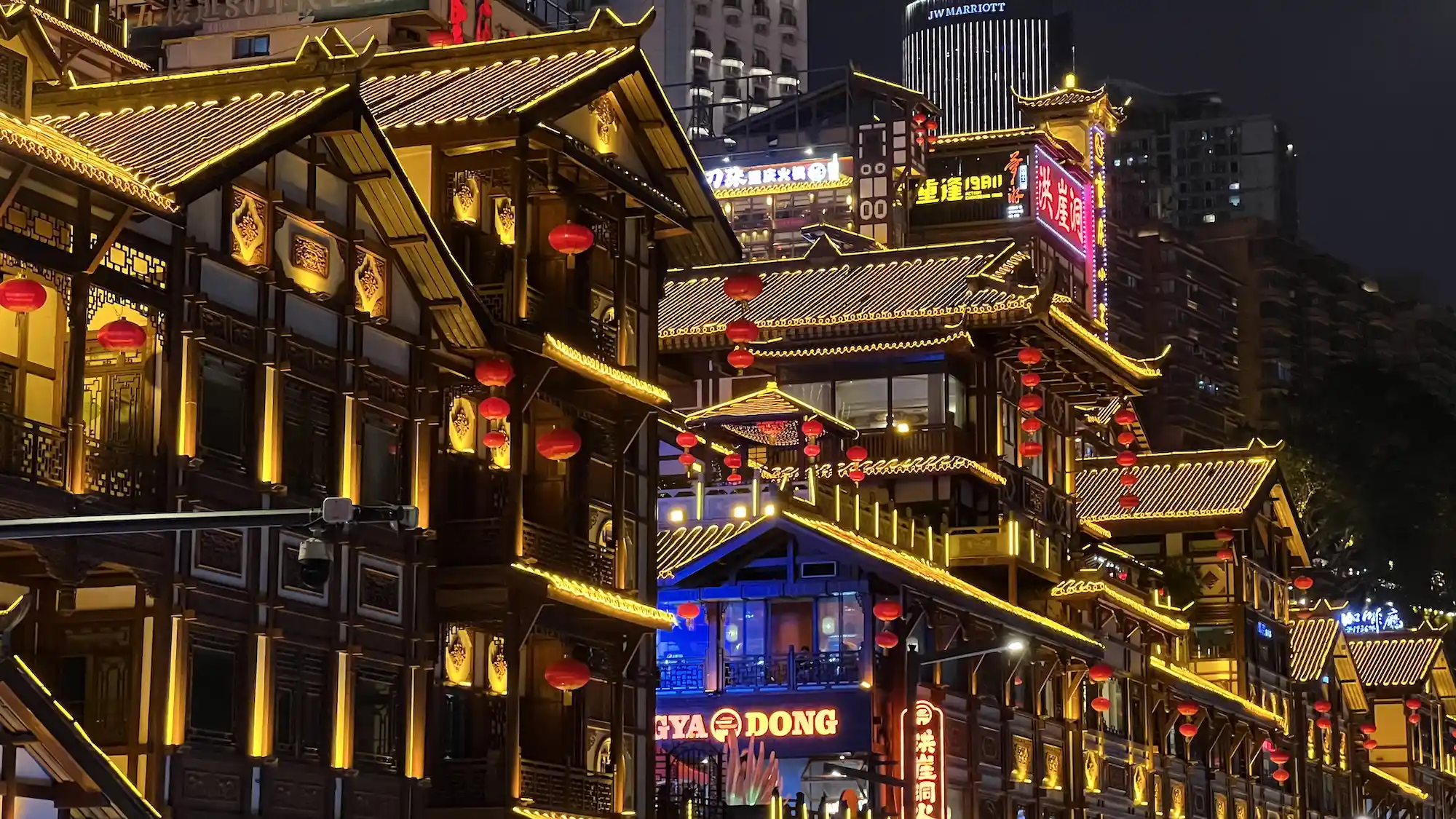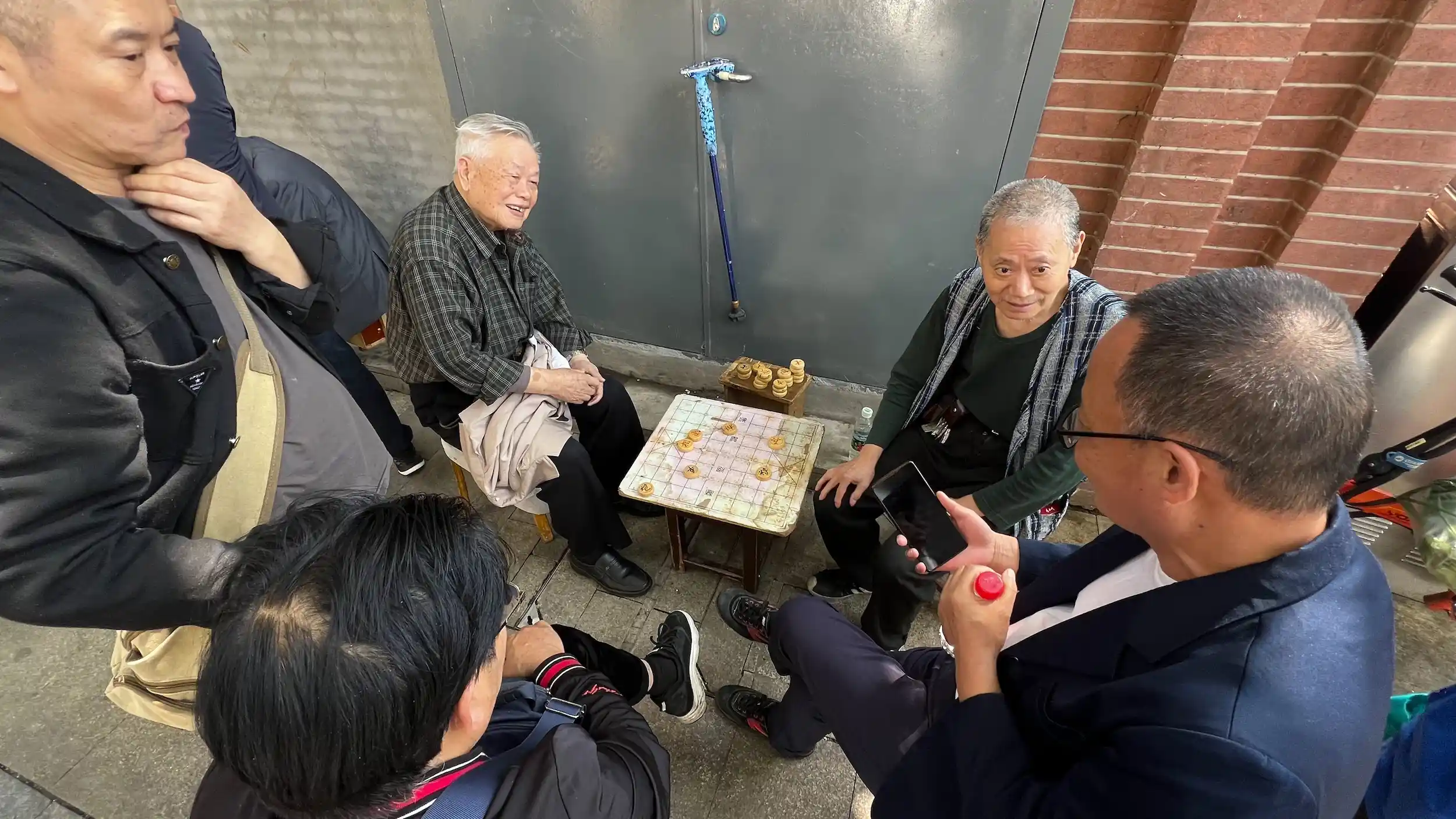
In the heart of southwest China, surrounded by mountains and bathed by the Yangtsé and Jialing rivers, the city of Chongqing (重庆, Chongqìng), one of the four municipalities under central jurisdiction of the country with Beijing, Shanghai and Tianjin is majestically. This megaciudad, known as the “mountain city” or “city of the fog”, represents one of the most fascinating urban developments in Asia.
If you are thinking of traveling to this fantastic city in this article we tell you what to do and what to do in Chongqing in 2025. Let’s start with a little context about the city.
Location and singularity
Chongqing occupies a strategic position in the interior of China, constituting the main gateway to the western region of the country. Its injured geography has resulted in a metropolis built at different levels, with skyscrapers that seem to sprout directly from the mountains, which has earned it the appellation of the “vertical city.”
Among the Chinese cities, Chongqing stands out for its extraordinary topography and its particular climate, with hot and humid summers and winters covered by a mist fog that surrounds its buildings.
It is recognized as the economic capital of western China and an important industrial and commercial center that has experienced vertiginous development in recent decades. Many of the automotive brands that we begin to see in the West have their origin in Chongqing.
History: from ancient port to mega city
Chongqing’s story goes back to more than 3,000 years, when it was known as Jiangzhou (江州). During the Song dynasty, the city was called Chongqing, which means “double celebration”, commemorating the coronation and subsequent rise of a local prince.

A crucial chapter in its history occurred during World War II, when it served as a provisional capital of China between 1937 and 1945, after the Japanese invasion. The city resisted intense bombing and became a symbol of Chinese resistance. This period left a deep mark on Chongqing’s identity and many historical sites related to this era can be visited.
essential to visit in Chongqing
Chongqing and its surroundings constitute an immense region with countless attractions to visit. Here we highlight the great attractions for which the province of Chongqing is known.
Hongya Dong Cave

The historical heart of Chongqing houses the Hongya Dong (洪崖洞, Hóngyá Dòng) cave complex, a traditional style structure built on a cliff that houses restaurants, shops and tea houses.
This complex, illuminated at night with infinite orange yellow lights, offers one of the most iconic postcards in the city and spectacular views on the Jialing River.
From the river walk in front you can enjoy spectacular views of the complex.
The three gorges of Yangtsé
Although they are not directly in the city, a cruise for the three throats (三峡, sān xiá) constitutes an essential experience. This natural wonder, transformed by the monumental dam of the same name, continues to offer landscapes of sublime beauty between steep gorges and Emerald waters.
Dazu Rock Carvings
The rock engravings of Dazu (大足石刻, Dàzú Shíkè), declared a World Heritage by UNESCO, are about two hours from the city. These Buddhist, Taoist and Confucian sculptures carved in the mountains between the IX and XIII centuries represent a masterpiece of Chinese religious art.
Wulong Karst
Wulong’s karst landscape (武隆, Wǔlog), also world heritage, offers spectacular geological formations, including the natural bridge of Tiansheng (天生桥, tiānshēng qiáo), the three natural throats and the Salamandra valley. Its overwhelming beauty has served as a stage for international films.
Parks, temples, museums, viewpoints and old streets: urban oasis, spirituality and history
Arhat temple

With more than a thousand years of history, the Arhat Temple (罗汉寺, Luóhàn Sì) houses 500 natural clay statues representing Buddhist monks, each with a unique expression. It is an active place that offers a window to traditional Chinese spirituality.
The Huguang guild: architectural testimony of historical migration in Chongqing

The Huguang Guild Hall (重庆湖广会馆, Chongqìng Húguǎng Huìguǎn) represents one of the best preserved architectural treasures of Chongqing and a fascinating chapter of its history. Built during the Qing dynasty, between 1759 and 1766, this impressive complex served as a community center for immigrants from the provinces of Hunan and Hubei (formerly known as Hugang) that were established in Chongqing.
The complex, which covers more than 25,000 square meters, stands out for its exquisite wood carved, its detailed stone reliefs and its colorful paintings that narrate confucian stories and popular legends. Its five consecutive courtyards house a temple dedicated to Guandi (关帝, Guān Dì), deity of commerce and war, as well as spaces that functioned as courts, schools and meeting centers for merchants.
Currently turned into a museum, the Huguang guild offers visitors an exceptional window to the architectural, religious and commercial traditions of imperial China, as well as a testimony of the migratory patterns that have shaped Chongqing’s multicultural identity over centuries.
Eling park
Located at the top of Mount Eling, this park offers impressive panoramic views of the city and rivers. With its pagoda, artificial lakes and lush vegetation, it constitutes a haven of peace in the middle of the urban bustle.
Shibati: The stone stairs that narrate the past of the vertical city

Embedded in the heart of Chongqing, the ancient street of Shibati (十八梯, Shibātī), whose name literally means “eighteen stone stairs”, represents one of the most evocative vestiges of the city’s past before its vertiginous modernization.
This labyrinth of stone stairs, which descended to wind through the steep hill from the center to the Jialing River, constituted in the past one of the main arteries for thousands of porters who transported merchandise from the docks. Its narrow alleys flanked by traditional wooden houses, small family and humble housing shops reflect the authentic daily life of Chongqing of yesteryear.
Shibati embodies the tension between preservation and progress that defines contemporary China, offering an overwhelming contrast with the gleaming skyscrapers that now dominate its horizon, a juxtaposition that captures the accelerated transformation of the metropolis in just a few decades.
People’s park
The People’s Park (人民公园, Rénmín Gōngyuán) is an emblematic green space where local inhabitants practice Tai Chi in the morning, play the Mahjong and enjoy improvised performances. It is a perfect place to observe everyday life and local culture.
Chongqing Natural History Museum (自贡恐龙博物馆)

The Chongqing Natural History Museum houses some of the best preserved dinosaur fossils in the world and deserves a visit despite being somewhat away from the center.
In it you can contemplate fossils of complete dinosaurs nests and complete skeletons of huge dinosaurs up to 20 meters long. Some of the fossils of the museums date from 150 million years ago.
Longmenhao: the port neighborhood that tells the river history of Chongqing

The old street of Longmenhao is located on the banks of the majestic Yangsé River, the historic Longmenhao neighborhood (龙门浩, Lóngeménhào) represents one of the corners with the greatest authenticity of Chongqing, where the city’s port remains alive between steep alleys and traditional buildings.
This old enclave, whose name literally means “Dragon Gate”, was for centuries the main commercial port of the region, serving as a vital link in the commercial routes that crossed the Yangsé River.
Its characteristics suspended houses (吊脚楼, diàojiǎolóu), built in harmony with the injured topography of the city, cling to the slopes on successive terraces, offering an outstanding example of vernacular architecture adapted to the mountainous terrain. Touring Longmenhao is immersing himself in an urban landscape of endless stairs, narrow alleys and community courtyards where the inhabitants maintain a lifestyle that seems to resist the passage of time.
The ancient docks, the hundred tea houses and the small handmade workshops transport the visitor to the time when the coolies loaded merchandise through the steep paths between the bustle of merchants and barqueros, composing a stamp that captures the historical essence of Chongqing as a city forged by its rivers.
Spicy and vibrant gastronomy

Chongqing’s kitchen is worldwide famous for its intense itching and complex flavors. Some emblematic dishes include:
- Hot Pot of Chongqing (重庆火锅, Chongqìng huǒguō): a boiling cauldron with chile and spices where meats, seafood and fresh vegetables are cooked. It is more than a meal; It is a social experience.
- Chongqing noodles (重庆小面, chongqìng xiǎomiàn): noodles served in a spicy broth with minced meat, soy and chives outbreaks.
- Laziji chicken (辣子鸡, Làzǐjī): pieces of fried chicken with an abundant amount of chiles and sichuan pepper.
- Apestoso tofu (臭豆腐, Chou Dòufu): Despite its strong smell, this fried fermented tofu is a local delicacy that surprises with its flavor.
The gastronomic experience in Chongqing is intense and memorable, being spicy not only a seasoning but a fundamental part of local identity.
Commercial areas for the traveler
Jiefangbei CBD
The commercial district of Jiefangbei (解放碑, Jiěfàngbēi) is Chongqing’s financial and commercial heart, full of skyscrapers, luxury shopping centers and the emblematic liberation tower. The pedestrian zone offers international and local stores next to high -end restaurants.
Ciqikou street
In contrast to the modernity of Jiefangbei, the old town of Ciqikou (磁器口, Cíqì Kǒu) offers a traditional commercial experience. Its cobbled streets house artisan workshops, antique stores, tea houses and street food stalls that transport the visitor to the China of yesteryear.
Chaotianmen
The Chaotianmen market (朝天门, Cháotiānmen), located where Yangsé and Jialing rivers converge, is one of the largest wholesale markets in Western China. Here you can find from fabrics and clothes to household items and souvenirs at very competitive prices.
Chongqingren people: Mountain Forged Character

The inhabitants of Chongqing, known as Chongqingren (重庆人, Chógqìng Rén), are famous throughout China for their direct character, their tenacity and passion for spicy. Forged in a demanding geographical environment of mountains and rivers, they have developed a resilient mentality that allows them to face the difficulties with determination.
The Chongqingren are known for their genuine hospitality and their relaxed lifestyle despite the frantic rhythm of their city. They love spending time in local tea houses (茶馆, Cháguǎn), where they talk animatedly while playing Mahjong, an almost obsessive hobby in the city.
A distinctive characteristic of the premises is their love for spicy food, which consume in quantities that surprise visitors from other regions of China. There is a popular saying that states that Chongqingren can support any degree of spicy.
In the Chinese imaginary, the inhabitants of Chongqing represent the perfect fusion between the traditional hospitality of the South and the robustness of the North, creating a unique cultural identity that is reflected in its local dialect, a variant of the mandarin dotted with colorful and direct expressions.
Nearby escapes: nature and culture a short distance
Fengdu, the city of ghosts
About three hours by Boat River from Chongqing, Fengdu (丰都, Fēngdū) is known as the “city of ghosts” for its temples complex dedicated to the underworld according to Chinese mythology. His sculptural representations of judgment in the hereafter offer a fascinating immersion in traditional beliefs.
Zigong and its dinosaurs
The city of Zigong (自贡, Zìgòng), about four hours by road, houses one of the best dinosaurs museums in Asia, with exceptionally preserved fossils discovered in the region. It is also famous for its salt production and its elaborate lanterns during the spring festival.
Jinfo Mountain Natural Reserve
Mount Jinfo (金佛山, Jīnfó Shān) is a nature reserve with impressive karst formations, primary forests and a rich biodiversity. Its paths allow you to enjoy walks of different difficulty between dream landscapes.
Chongqing represents the pulse of contemporary China: a vibrant metropolis where tradition and ultramodernity coexist in a fascinating balance.
To learn about this Chinese southwest jewel with all its depth and plan a trip as it includes the most authentic experiences, do not hesitate to contact our Asiahop specialists.
Our Chinese destinations will help you design a personalized itinerary that captures the essence of this extraordinary city and its region.